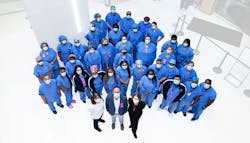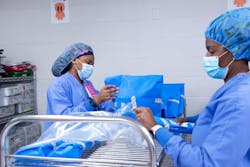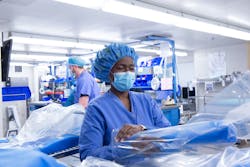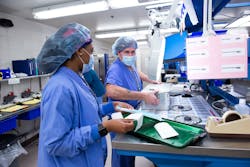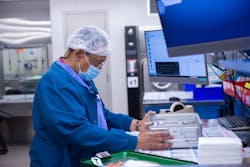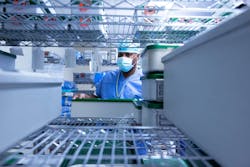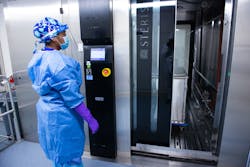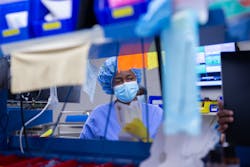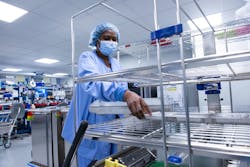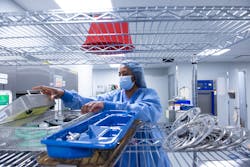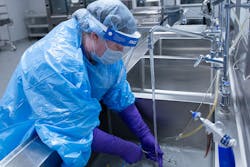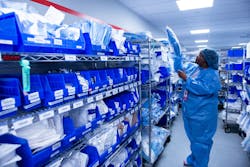Walk up to any titleholder – technician, lead technician, supervisor, clinical educator, manager or director – within a hospital Sterile Processing & Distribution (SPD) department and ask him or her whether they – individually or department-wide – feel respected by others throughout the organization, and they’ll likely respond with tepid ambivalence or indifference or even an emphatic “No!”
Not so at Bayhealth, a multihospital system based in Dover, DE.
Through the twists and turns of necessary changes in leadership, policies and procedures and standards, Bayhealth’s Sterile Processing team waved that emotional response goodbye a few years back.
To achieve such a milestone, you probably surmise that Bayhealth’s SPD team simply started reporting to Surgical Services from Supply Chain … like so many other colleagues and competitors.
Nope.
Then you probably think that Bayhealth’s SPD team simply started reporting to Supply Chain from Surgical Services … like so many other colleagues and competitors a few decades earlier.
Wrong again.
So, if SPD doesn’t report up through Surgical Services and it also doesn’t report up through Supply Chain, where is its place? And how is that even possible, let alone allowable?
“Originally SPD and Supply Chain were integrated, but it was identified that they have unique skill sets and separate purposes for our health system,” said Brian Dolan, MHSA, CRCST, CMRP, LSSGB, Vice President, Resource Management. “Trying to bundle both may work for some organizations, but to truly focus on SPD-driven improvements we had to make a clear distinction between the two entities. They still work in concert with each other but are now more siblings than conjoined twins.”
The simple answer? You can trace this transformation to a C-suite attitude near the top after the department seemingly reached rock bottom before 2019.
“Sterile processing had a history of lower performance here, and we had a [Joint Commission] survey that really triggered the need for a revitalized view into SPD,” Dolan recalled. “That was the tipping point – not a unique situation. [Bayhealth] overall had been looking at their talent and identifying areas where they needed to raise the bar for standards to meet our strategic plan objectives.”
Deborah Watson, who had been promoted to Senior Vice President and Chief Operating Officer back in 2010, embraced the value of SPD and made it her mission to address opportunities within the department, according to Dolan. Watson identified the need to elevate the department’s standards and share the value of SPD within the organization. This involved creating a new department structure separate from Supply Chain, providing professional autonomy, eliminating the need for consultant and contingent labor, investing in necessary resources and establishing dedicated and permanent leadership over the department.
To motivate the SPD team and provide them with a clear vision of direction and rationale for the changes in leadership, training, tool development and certification requirements, the C-suite leader set “SPD of the Year” as the spotlight, the North Star, the drive to be the best, Dolan remembers.
Mission accomplished.
Because of Bayhealth SPD’s comprehensive cultural, performance and structural improvements, its professional relationships with Surgical Services and Infection Prevention through a dedicated liaison and daily rounds, its expanded – and growing – scope of practice, its enhanced education, training and certification achievements and its recognized value within the C-suite, Healthcare Purchasing News named Bayhealth SPD the 2021 SPD Department of the Year.
Against the general nationwide backdrop of productivity pressures, lack of access to resources such as device manufacturer instructions for use (IFUs), processing technologies and supplies, communication breakdowns between SPD staff and Perioperative Services (OR), gaps in universal training/certification requirements and varied levels of self-respect and confidence, Bayhealth’s SPD team learned to view these barriers as challenges to overcome and provide their customers with high-quality customer service, according to Melissa McVaugh, MS, BSN, HCQS, CRCST, CIC, LSO, CHL, LSSGB, Director, Sterile Processing.
McVaugh cites as examples her team’s dropping their quality variances (defects) to no more than four per month on average from 96, eliminating immediate-use steam sterilization (a.k.a. flashing) completely and all 42 team members being certified. This evidence demonstrates how the SPD team at Bayhealth successfully overcome their own barriers, made leaps in quality improvement and boosted their reputation throughout the health system, she adds.
Time to move
Before 2019, SPD functioned as a subset of Bayhealth’s materials management structure. To wit: SPD originally was embedded in a department called “Central Supply” and cobranded with the supply chain functions performed with the Operating Room (OR).
The COO decided to carve out the sterile processing function and escalate the importance of SPD, bringing in several consultants to manage a joint project for SPD and Perioperative Services improvement work, according to McVaugh. The COO outlined a departmental structure that featured a director, managers at each Bayhealth site, a system educator and an instrument coordinator. Supervisors were appointed to lead every shift and to provide coverage 24/7. She then created a Vice President role that required previous leadership experience in surgical operations, infection prevention and sterile processing.
Dolan and McVaugh were recruited around the same time in late 2019, McVaugh recalls.
“We were given the goal of excellence and then the autonomy to do what we needed,” McVaugh said, acknowledging the unique experience that senior-level support generated as the COO remained highly visible throughout the process by attending meetings. Still, McVaugh shared four useful tips for those yearning for something similar.
“SPD leaders need to become stronger storytellers,” she indicated. “They need to know their data, know their industry and know best practice. They have to make those connections for those who don’t understand [and] appreciate the complexity of SPD.
“SPD leaders must remove the shroud of ‘basement life’ and recognize that they are truly clinical professionals,” she continued. “This takes some guts to advocate for a department that typically is under-resourced. [Brian and I] have done this at previous facilities, and it comes back to knowing your value in the great system – connect to the strategic plan.
“SPD leaders need to also foster curiosity, constantly assess organizational scorecards, etc., to find where SPD can make an impact – tell the story, show them how,” she noted.
“Find your allies,” she concluded. “[We] worked hard to find our allies, being new to BH. We quickly buddied up with Infection Prevention, Regulatory and other folks who have high visibility in the organization. We shared our strategies and emphasized transparency. This recruits other areas to also speak your truth and invite you into conversations you had not previously been at the table for.”
Dolan and McVaugh quickly assessed operations and staffing using a data-driven approach that linked SPD production to OR case flow and were able to build and promote a strategy for double staffing levels to satisfy leadership, specialist roles and front-line teams. In fact, Dolan had brought a “calculator” with him from a previous organization that he used to justify to the CFO the need to increase full-time equivalents (FTEs) related to surgical volumes.
“Showing the CFO here at Bayhealth that there was a lot of thought, data analysis and productivity understanding removed any arguments that could have been started if it was just ‘because we think so,’” Dolan noted. “Value is in the details.”
Originally, Dolan was hired to lead the Supply Chain division with SPD technically reporting up through him. But that didn’t sit too well with Dolan who had 18 years of Surgical Service and SPD experience to McVaugh’s 23 years. “We looked at the combination of services that ranged from value analysis, procurement, instruments, supplies, equipment and services and identified these were more ‘resources’ than just supplies,” he said, referencing the division’s name change to Resource Management. “We also wanted to have a name that the customers could see that we are here to be a resource…not a cold chain of commodities.”
The philosophy also helped to balance the playing field. Dolan recently earned his CRCST, adding to his green belt in Lean Six Sigma; McVaugh recently earned her green belt in Lean Six Sigma, adding to her CRCST.
Bayhealth Kent Campus
Out with “old school”
Prior to 2019, SPD concentrated on providing service to Perioperative Services. With the restructuring, however, came invitations to upper management to work collaboratively on establishing evidence-based, standardized practices that extend beyond Perioperative Services, hospital-based ambulatory surgery, nursing floors, Labor & Delivery, ambulatory surgery centers and other Bayhealth sites requiring SPD services, according to McVaugh. They extend instrument procurement and optimization and environment of care (EOC) consulting, as well as high-level disinfection standardization and IP support to the system’s acute care hospitals, ambulatory practices.
McVaugh routinely meets with Infection Prevention (IP) to discuss issues outside of SPD. Further, she and her managers also attend EOC rounding at various Bayhealth sites to offer IP- and SPD-related feedback. SPD also retains a seat on the IP committee.
“During meetings we quickly built a relationship with that team by showing them that we look at things not just at a myopic level, but a system impact,” she added.
The COO also incorporated SPD into the organization’s shared governance model where a team of Perioperative Services and SPD staff from each Bayhealth hospital campus participates in an Operations Performance Improvement Team that meets monthly, reinforcing accountability and responsibility for customer service levels.
“This was aimed at creating a joint venture on improvements in SPD,” McVaugh noted. “It takes both sides to maximize the value of sterilization services. SPD cannot own all of the components as the Perioperative Services has major influence on our success. Service was a big topic at the beginning, but it has translated more to a partnership that both sides have to contribute towards. SPD and Perioperative Services are equals. It can vary on the organization’s culture – overall and in Perioperative Services – that can impact [and] support SPD integrating in this way. We have both been in organizations that either accepted or rejected the value of SPD. Both of us agree that Bayhealth has created an environment that we find unique and authentically focused on SPD.”
SPD also designated one FTE to serving as a liaison for rounding, which enables the staff to know each other personally and by name to foster communication and respect, according to McVaugh. Previously, SPD feedback arrived via error reports that weren’t able to be addressed in real time before they escalated into an “intraoperative concern,” she added.
One SPD liaison rounds during the day shift and an evening/night supervisor rounds in the evening, multiple times per day. The liaison works with the educator to develop any plans on lessons during the day, McVaugh notes.
Productivity gained
SPD targeted any competency gaps internally, ensuring that the entire team followed the standards issued by ANSI/AAMI, AORN, APIC and The Joint Commission.
“We focused on standard access to IFU information, updated count sheets and SPM workflow, and identified some of the unnecessary steps that staff may have been taking during processing,” McVaugh said. “Once the competency gaps were identified, SPD developed a recruitment strategy for new staff members that could help close those competency gaps by bringing in certified staff members. Once all staff were in place, we began to cross-train each employee.”
McVaugh admits that certifying and cross training all employees within a year or so was not as challenging as one might expect “once we provided the tools and structure to the staff,” she indicated. “They had not had a framework to do this in the past [so it] was a foreign concept, but they could understand with leadership direction.”
SPD also assessed equipment functionality and efficiency to meet productivity goals and developed closer relationships with the Clinical Engineering team to maximize equipment uptime and to communicate with clarity and transparency when potential bottlenecks emerged due to downtime. McVaugh hails the “well-trained CE technicians that understand the importance of SPD work.”
Last year, throughout the rise of the COVID-19 pandemic, SPD worked with Perioperative Services to fully eliminate immediate-use steam sterilization (IUSS a.k.a. “flashing”).
“This was a joint decision,” McVaugh admitted. “Perioperative Services Director was all about it! Collaboration and communication are key. We still have occasions where these issues bubble up, but we always find a way through it. The biggest thing is everyone recognizes that IUSS was not a good practice and accepts when delays happen. They may not be happy about it, but they know that best practice should be followed.”
How did SPD and Perioperative Services make this happen?
“This was accomplished by removing autoclaves in the OR cores, implementing the use of OneTray, implementing a data-driven approach to increasing inventory and improving communication with Perioperative Services regarding inventory versus scheduling,” she responded.
Bayhealth Sussex Campus
Empowering SPD
Prior to 2019, SPD professional development emerged from a simple process: On-the-job training. The COO set a lofty goal for the new leaders: Achieve 100% staff certification of technicians.
Right before COVID-19 surfaced in March 2020, SPD leaders had set up a three-hour study group to meet every Sunday for 16 weeks. The pandemic interrupted the schedule until the organization allowed small groups to meet. Today, Bayhealth’s SPD team is fully certified.
Meanwhile, McVaugh and Dolan are working on a career progression ladder to link pay increases as a reflection of certification, and they’re also working with IAHCSMM to create an advocacy group that develops a national standard business case for compensation ties to certification, according to McVaugh.
Grunderson Jean-Philippe, Manager of Bayhealth’s Kent Campus SPD department, opened a sterile processing training academy called BE INSTRUMENTAL LLC, where he provides sterile processing, infection control and instrumentation education for students from Delaware, New Jersey and the nearby Philadelphia metropolitan area. Jean-Philippe has been teaching sterile processing for more than six years to students seeking a career in the profession and want to make a difference in a patient’s life, McVaugh says.
In fact, BE INSTRUMENTAL, through Bayhealth, is affiliated with Delaware Technical Community College to provide clinical training for students enrolled in the sterile processing program. Through this program, students complete the 400 hours of hands-on training as part of their curriculum and gain the experience needed to work in SPD, she adds.
For two years SPD also concentrated on staff satisfaction to solidify the cohesiveness of the team – including experience/knowledge sharing, boosting morale and trust among each other and with Perioperative Services. From delegation to empowerment, team building to development, the efforts yielded a 6% overall increase in employee satisfaction in one year alone, according to McVaugh.
That overall measurement contained two key statistics – a 22% increase in “going above and beyond” and a 24% increase in “sufficient time to do their work,” McVaugh cites.
For the first one, the SPD leadership team used the volunteer fireman’s analogy: “Volunteer fireman risk their lives going into burning buildings to save strangers. Why do they do that? Because they feel valued, respected and needed,” she said. “Leaders emphasized this mantra and wanted all staff to gain the same mentality/feeling of the Volunteer fireman. Team members will also always go above and beyond when motivated by strong leadership – Bayhealth’s investment in the new structure as well as successful recruitment of strong leaders further solidified this area. We also saw gains in this area with enhancements with Perioperative Services-SPD relationship and that team members feel that they are being seen by their customers.”
McVaugh attributes the second one to department streamlining and the provision of education, which included the hiring of an educator to the SPD management team.
“Education empowers workflow,” she said. “When we have variation in workflow, it is easy to have inconsistent time to complete tasks, various order of operations, etc. In the spirit of lean, educating to one process can always yield greater time and level loading – it is clear our staff feels that. I think that any time an organization develops standards, gives expectations for timing per step and allows the team to have the knowledge to either remove unnecessary steps or to improve how they can perform a step, the results will always yield more time.”
Efforts seem to be paying off as shown by SPD-collected data on error frequency. In 2019, SPD recorded 622 variances; that number plummeted to 162 in 2020. As defects occur, SPD investigates them in real time using their SPM software and identifies their root causes, according to McVaugh. SPD strives to reduce defects to below 0.8% by the end of the year, something McVaugh says will be achieved.
This year, SPD leadership created a dashboard to showcase their performance with customers. Dolan used a SmartSheet application and Excel to create this web-based tool for internal sharing.
Looking ahead, SPD will continue functioning as a high-performing team through effectiveness and efficiency, according to McVaugh. This includes strengthening the “systemness” of SPD and eliminating barriers between sites of care, using data and analytics to assess service delivery, collaborating with other departments to facility better patient outcomes, working with suppliers and providers to optimize instrument inventory and using evidence-based practices to drive a consistent service model and standardized sterilization procedures, she adds.
McVaugh admits that two elements of the strategic plan pose the greatest challenges. “Instrument optimization is the hardest because it involves forging new direct relationships with surgeons,” she said. “SPD usually had to work through nursing for these. We are taking ownership of Perioperative Services instrument budget so we can have direct discussions. Data is also a challenge as we need to continue scrubbing our sources.”
As for the least challenging?
“Systemness,” she answered. “We have a great foundation and team invested in our long-term plans.”
McVaugh believes that any SPD team should be able to emulate what they’ve accomplished within the last two years – and within the same timeframe.
“It starts with leadership support and setting a solid goal and plan of attack for improving the area,” she insisted. “You must harness the data and understand current state, gaps and needs. Only then can you really identify the countermeasures necessary to move forward.”
All photos courtesy Bayhealth.
Bayhealth SPD team salutes supplier partners as instrumental in success
Bayhealth SPD team:
Leadership and Support Staff
Melissa McVaugh, Director, Sterile Processing
Brian Dolan, Vice President, Resource Management
Deborah Watson, Chief Operating Officer
Front-Line Staff
Grunderson Jean-Philippe (Jean), Manager
Rita Amponsah, Tech 2
Phebe Best, 3rd shift supervisor
Tanya Brooks, 2nd shift supervisor
Nicole Concepcion, Tech 1
Jennifer Daniels, 1st shift lead tech
Sylvia Fletcher, Tech 2
Michele Ginn, Tech 1
Amber Guy, Tech 1
Carol Hays, 1st shift lead tech
Inis Hicks, 1st shift lead tech
Naomie Jean Philippe, Tech 1
Charles Jones, Tech 2
Sikani Kenjyatta, Tech 1
Leonard McClain, 2nd shift Lead
Chidi Nkwopara, Tech 2
Marilyn Parnell, Tech 1
Jason Patterson, Tech 2
Shellie Pearsall, Tech 2
Daniel Robb, Tech 2
Scott Robinson, Tech 2
Thomas Snow, Tech 1
Zachary Swan, 3rd shift lead tech
Taylor White, Tech 1
Season Whiting, Tech 1
Alice Williams, Tech 2
Turkessa Wilson , Tech 1
Thomas Haley, Instrument Coordinator
Mikel Shans, Manager
Breanna Bowler, Tech II
Brittany Trott, Tech II
Chrissy Clendaniel, Tech II
Deborah Gonzalez, Tech II
Jeanine Francois, Tech II
Jo Ann Matthews, Tech II
Kayla Exline, Tech II
Lisa Pressley, Tech II
Rasheena Muhammad, Educator
Shayla Walker, Lead Tech
Tiria Wright, Tech I
About the Author
Rick Dana Barlow
Senior Editor
Rick Dana Barlow is Senior Editor for Healthcare Purchasing News, an Endeavor Business Media publication. He can be reached at [email protected].
